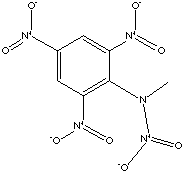2,4,6-Trinitrophenylmethylnitramine
- Tetryl
- N-Methyl-N,2,4,6-tetranitroaniline
- Nitramine
- Tetralite
- Picrylnitromethylamine
- Benzenamine, n-methyl-N,2,4,6-Tetranitro

2,4,6-Trinitrophenylmethylnitramine | |
| |
| Formula | C7H5N5O8 |
| Structure |  |
| Description | Colorless to yellow, crystalline solid. Odorless. |
| Uses | Used as an explosive in detonators and primers, as an intermediary detonating agent for other less sensitive, high explosives, and as a booster charge for military devices, it may also be employed as an explosive charge. |
| Registry Numbers and Inventories. | |
| CAS | 479-45-8 |
| EC (EINECS/ELINCS) | 207-531-9 |
| EC Index Number | 612-017-00-6 |
| EC Class | Explosive; Toxic; Danger of cumulative effects |
| RTECS | BY6300000 |
| RTECS class | Mutagen; Primary Irritant |
| UN (DOT) | 0208 |
| Merck | 12,6664 |
| Beilstein/Gmelin | 964788 |
| Beilstein Reference | 4-16-00-00895 |
| Canada DSL/NDSL | NDSL |
| US TSCA | Listed |
| Austrailia AICS | Listed |
| New Zealand | Listed |
| Japan ENCS (MITI) | Listed |
| Properties. | |
| Formula | C7H5N5O8 |
| Formula mass | 287.15 |
| Melting point, °C | 131.1 |
| Boiling point, °C | 504 |
| Vapor pressure, mmHg | 3E-10 (25 C) |
| Density | 1.73 g/cm3 (15 C) |
| Solubility in water | 200 mg/L |
| Partition coefficient, pKow | 1.49 |
| Heat of vaporization | 77.3 kJ/mol |
| Heat of combustion | -1222 kJ/mol |
| Hazards and Protection. | |
| Storage | Keepsolution in dark. Protect from shock. |
| Handling | All chemicals should be considered hazardous. Avoid direct physical contact. Use appropriate, approved safety equipment. Untrained individuals should not handle this chemical or its container. Handling should occur in a chemical fume hood. |
| Protection | Skin contact may be minimized by the use of impervious fabric clothing fastened at wrists & neck, rubberized aprons & half sleeves & caps or turbans. |
| Respirators | Use NIOSH/MSHA approved respirator appropriate for exposure of concern. |
| Small spills/leaks | Keep sparks, flames, and other sources of ignition away. |
| Stability | Is highly stable losing virtually no weight on prolonged storage at 80 C. |
| Incompatibilities | Contact of tetryl with some oxidizable materials may cause fires and explosions. Contact of hydrazine with n,2,4,6-tetranitroaniline caused ignition. Tetryl detonates spontaneously on contact with trioxygen difluoride. |
| Decomposition | May explosively decompose on shock, friction, or concussion. Decomposes explosively on heating to 187 C. |
| Fire. | ||||
| Flash Point,°C | 187 (explodes) | |||
| Fire fighting | Dangerously explosive. Do not fight fires in a cargo of explosives. Evacuate area and let burn. | |||
| Fire potential | Dangerous fire. Explosion risk | |||
| Hazards | Dangerously explosive. Do not fight fires in a cargo of explosives. | |||
| Combustion products | Toxic gases and vapors (such as oxides of nitrogen and carbon monoxide) may be released in a fire involving tetryl. | |||
| Health. | |
| Exposure limit(s) | TLV: 1.5 mg/m3 (as TWA) (ACGIH 1997). OSHA PEL: TWA 1.5 mg/m3 skin NIOSH REL: TWA 1.5 mg/m3 skin NIOSH IDLH: 750 mg/m3 |
| Exposure effects | Symptoms of CNS depression from tetryl exposure include weakness, malaise, headache, lassitude and narcosis. |
| Ingestion | Nausea and vomiting have been reported with occupational exposure. |
| Inhalation | Tetryl is a strong respiratory irritant. |
| Skin | Tetryl is a strong skin and mucous membrane irritant. |
| Eyes | Tetryl can cause inflammation of the eye and sensitization-type dermatitis on the eyelids. |
First aid | |
| Ingestion | The possible benefit of early removal of some ingested material by cautious gastric lavage must be weighed against potential complications of bleeding or perforation. Activated charcoal activated charcoal binds most toxic agents and can decrease their systemic absorption if administered soon after ingestion. Activated charcoal: administer charcoal as a slurry (240 ml water/30 g charcoal). Usual dose: 25 to 100 g in adults/adolescents. |
| Inhalation | Move victim to fresh air. Monitor for respiratory distress. If cough or difficulty breathing develops, evaluate for respiratory tract irritation, pneumonitis or bronchits. Administer oxygen and assist ventilation as required. |
| Skin | Remove contaminated clothing. Wash exposed area with soap and water. If symptoms persist, seek medical attention. Launder clothing before reuse. |
| Eyes | If symptoms develop, immediately move individual away from exposure and into fresh air. Flush eyes gently with water for at least 15 minutes while holding eyelids apart; seek immediate medical attention. |
| Transport. | ||
| UN number | 0208 | |
| Response guide | 112 | |
| Hazard class | 1.1D | |
| Std. Transport # | 4901541 | |